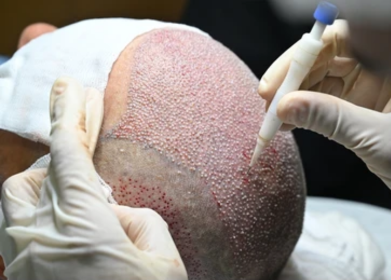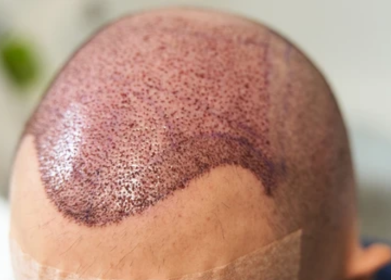Hair Transplant for Men in India
Hair loss is a common issue among men, with over 60% experiencing significant hair loss by age 50. If you’re seeking an effective way to address this problem, a hair transplant for men in India might be your solution.
At QHT Hair Transplant Clinic in India, we understand the emotional and psychological impact of hair loss. Our team of dedicated hair transplant professionals offers comprehensive hair treatment for men, using advanced techniques to ensure natural-looking results.
Now, let’s have a quick overview of hair transplantation.












Get the Hairline You Deserve! Explore Cutting-Edge Hair Transplants for Men –
What is a Hair Transplant?
A hair transplant is a surgical procedure in which hair follicles are moved from the back or sides of the scalp to the thinning or balding areas. This process helps restore your natural receding hairline and adds density to areas affected by hair loss.
It’s a popular solution for men looking to regain their confidence and achieve a fuller head of hair. The results are natural-looking and permanent. This makes it a reliable choice for hair replacement treatment for men.

Types of Hair Transplant
As you explore male hair transplant options, it’s essential to understand the different techniques available. Here are the main types:

Follicular Unit Extraction (FUE):
-
- Individual hair follicles are extracted from the donor area and implanted into the thinning or balding areas.
- Minimally invasive, leaves tiny, hardly visible scars.
- Shorter recovery time compared to other methods.

Follicular Unit Transplantation (FUT):
- The surgeon removes a strip of scalp skin from the donor area and harvests hair follicles from this strip.
- Allows for the transplantation of a large number of grafts in one session.
- Leaves a linear scar, which can be hidden by surrounding hair.

Direct Hair Implantation (DHI):
- Similar to FUE, but it uses a specialized tool to implant the follicles directly into the scalp.
- Offers precise control over the angle, direction, and depth of hair placement.
- Reduces handling of hair follicles, increasing survival rates.

Robotic Hair Transplant:
- Uses robotic technology to assist in the extraction and implantation process.
- Enhances precision and consistency.
- Can improve the speed and efficiency of the procedure.
Each type of hair transplant has its benefits and considerations. Consulting with a specialist can help you determine the best option for your needs.
What is the hair transplant cost in india?
Each type of hair transplant has its benefits and considerations. Consulting with a specialist can help you determine the best option for your needs.

Each type of hair transplant has its benefits and considerations. Consulting with a specialist can help you determine the best option for your needs.
Steps Involved in Hair Transplant Procedure
Consultation:
Meet with your hair transplant specialist to discuss your goals and assess your suitability for the procedure. Share your medical history and any concerns you may have.
Preparation:
Your doctor will provide pre-operative instructions, including avoiding certain medications or activities. You’ll receive information on what to expect during the procedure and how to prepare for it.
Harvesting Hair Follicles:
Your surgeon will remove healthy hair follicles from donor areas, typically from the back or sides of your scalp. Advanced techniques like FUE, DHI, or QHT (Quick Hair Transplant) may be used.
Recipient Site Preparation:
Your surgeon will make tiny incisions in the recipient area where the hair will be transplanted. The placement and angle of these incisions are crucial for achieving natural-looking results.
Graft Implantation:
The surgeon will carefully implant harvested hair follicles into the recipient sites one by one. This meticulous process ensures proper placement and density of the transplanted hair.
Post-Operative Care:
Your doctor will provide detailed instructions for post-operative care, including how to clean the transplant area and manage any discomfort. They will schedule follow-up appointments to monitor your progress and address any concerns.
Thinking about the financial side? Let’s break down the costs.
Get the Best Hair Transplant for Men in India! Book Your Consultation with Top Experts Today.
Hair Transplant Cost in India
When considering hair surgery in India, Hair transplant cost in India can vary based on the type of procedure and other factors. Here’s a breakdown:
| Type of Hair Transplant | Approximate Cost (INR) |
| Follicular Unit Extraction (FUE) | 30,000 – 1,50,000 |
| Follicular Unit Transplantation (FUT) |
25,000 – 1,25,000 |
| Direct Hair Implantation (DHI) | 40,000 – 2,00,000 |
| Robotic Hair Transplant | 75,000 – 3,00,000 |
Remember, these are rough estimates, and actual costs can vary depending on the factors mentioned below. It’s always best to consult a specialist for a personalized quote.
Factors Impacting Hair Transplant Cost in India:
Extent of Hair Loss:
The more extensive the area to cover, the higher the cost.
Technique Used:
Different methods like FUE or QHT have varying price points.
Clinic Reputation:
Renowned clinics may charge more due to their expertise and
Surgeon's Experience:
Experienced surgeons might charge a premium for their skills.
Geographical Location:
Costs can vary between cities and regions in India.
Insurance Coverage:
Unfortunately, insurance typically doesn’t cover hair transplant procedures as they’re considered cosmetic. However, it’s always worth checking with your provider to be sure.
Considering the benefits? Here’s why a hair transplant could be the right choice.
Benefits of Hair Transplant
Permanent Solution:
Hair transplant provides a long-term solution for hair loss as transplanted follicles continue to grow naturally.
Natural Results:
Unlike other methods, hair transplant yields natural-looking outcomes, seamlessly blending with your existing hair.
Low Maintenance:
Transplanted hair requires minimal care, allowing for regular washing and styling similar to natural hair.
Cost-Effective:
Despite initial expenses, hair transplant proves cost-effective over time, eliminating the need for ongoing treatments or products.
Quick Recovery:
Patients typically resume normal activities within days post-transplant, with full results visible in months.
No Side Effects:
Hair transplant procedures are safe with minimal side effects, such as temporary discomfort or swelling.
Looking for a natural solution to hair loss? Choose the best hair transplant clinic in India.
Why Choose QHT Hair Transplant Centre in India?
Celebrity Clinic:
QHT is a celebrity hair transplant clinic in India with a proven track record of delivering exceptional results.
Expertise:
With years of experience and expertise in hair transplantation, our hair transplant surgeon ensures that each patient receives personalized care and the best possible outcome.
State-of-the-Art Facility:
Our clinic is equipped with cutting-edge technology and modern facilities to provide patients with a comfortable and seamless experience throughout their hair transplant journey.
Natural-Looking Results:
Our skilled surgeon’s artistic approach and attention to detail result in natural-looking hairlines and fuller, thicker hair.
Comprehensive Care:
From the initial consultation to post-transplant follow-up, our team at QHT Clinic is dedicated to providing extensive care and support.
What is the hair transplant cost in india?
Transform your reflection and regain your confidence with a customized hair transplant solution.

Learn about the recovery process and post hair transplant care.
Hair Transplant Recovery and Aftercare

Initial Healing (Days 1-7):
Avoiding Physical Activity:
Medication Management:
Take prescribed medications as directed to prevent infection and reduce swelling, aiding proper healing.
Shampooing and Care:
Avoid Scratching:
Avoid scratching or rubbing your scalp to protect the grafts.
Shield from Sun and Dust:
Hair Growth:
Shedding of transplanted hairs in the weeks following the procedure is normal. These hairs will regrow after entering a resting phase.
Patience is Key:
Proper hair transplant aftercare is essential for adequate recovery and optimal outcomes.
What is the hair transplant cost in india?
Your journey to thicker, fuller hair starts here. Please consult skilled hair transplant specialists for desired results.

Hair Transplant Before and After Results

Before

After

Before

After
Get answers to commonly asked questions about hair transplant procedures and recovery.
Frequently Asked Questions
If you don’t find relevant answer please send us your queries on support@qhtclinic.com or Call +91-9084726916
What are the common causes of donor area pain after a hair transplant?
What is the success rate of male hair restoration?
Hair transplant success rates vary depending on the surgeon’s skill, technique, and patient health. Generally, modern procedures boast success rates of over 90%, with natural-looking results.
What are the side effects of hair transplant?
Potential side effects of a hair transplant may include temporary swelling, itching, redness, and numbness in the transplant area. These usually resolve on their own within a few weeks post-surgery.


